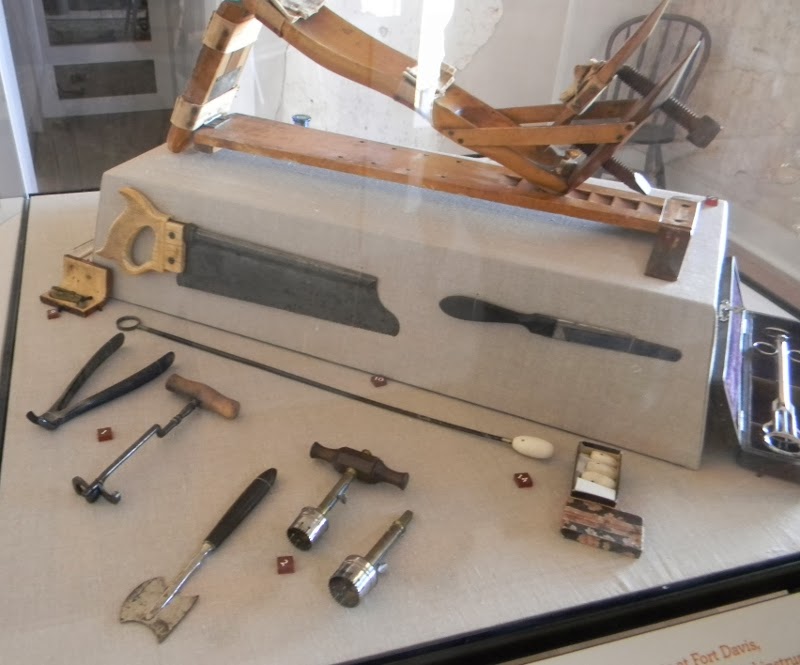Marfa is a curious mix of East Coast Minimalist art and West Texas poverty. As we were driving to Marfa on January 2nd, we saw a private jet land at the Marfa airport.
 |
| Marfa Courthouse |
We were going to Marfa to take the Chinati Foundation tour of the installation art on the old army base. The base was established in 1911 as a cavalry fort, and served as an army base until 1945. It was also a German prisoner of war camp. The army base, Fort Russell, was bought by the Dia Foundation, as a place for permanent exhibitions of Minimalist installation art.
Our tour was an all day tour, with a break for lunch. Unfortunately, photos were not permitted. We started with Judd's 100 aluminum boxes, spread over two buildings. Judd's art was considered to be minimalism; I tend to describe it as rectangular. The next stop was an installation in which a Russian artist portrayed abandoned Lenin-era schoolhouse,number 6. Then we went to the arena, where the art was primarily the building itself. Finally we went to town to see crushed car bodies. Our last stop before lunch was a temporary exhibit, in which an entire building became like a camera body. There was a lens in the south wall, and the view outside was projected, upside down, on the north wall.
We went to lunch as the very popular Future Shark restaurant, a spinoff of the Food Shark food truck. The wait was long, but the food was pretty good. All steam table food, nothing cooked to order. We kept seeing old cars around town with Food Shark written on the side. We were unsuccessful in finding a coffee shop, even after being told by two different people where it was. We found the street signage in Marfa lacking.
After lunch, we rejoined our tour. The first part was of a series of buildings, all considered one installation, containing diagonal fluorescent tubes in various colors and arrangements. We also saw Judd woodcuts, rectangular with lines. Perhaps the most bizarre exhibit was a room with many small pencil drawings, which looked like various slightly smudged pieces of paper; Cynthia envisioned the artist laughing at us. There was also a room of poems, generally involving a lot of repetition, but which I thought were somewhat interesting. We did not go over for a close look of the kilometer of groupings of concrete boxes....
Overall, we liked the Judd boxes and the Russian schoolhouse. We were not impressed by our "docent" (tour guide), a young woman who did not tell us very much, mostly leaving us to wander and absorb the installation. The tour was relatively small, 11 people; the visitors were mostly pretty quiet, perhaps at a loss for anything to say. Cynthia would not recommend a visit to Marfa unless you are in the area, or a fan of Minimalist art.
After the end of the tour, we headed back to our camper, in Davis Mountains State Park. I went up to look for birds at the bird feeders, but there were no birds feeding.
On January 3rd, we headed to McDonald Observatory for the guided tour. We had considered the star watching party, but decided that it would be too cold. The altitude of the Observatory is 7000 feet. Our guide was Marc, whose enthusiasm for astronomy engaged young and old. The focus of the talk in the auditorium was the sun, and he projected live images of the sun, including sunspots and solar prominences. After the auditorium talk, we drove up to the 107 inch telescope, where we went inside the dome, and he moved the telescope and the dome, to demonstrate the mechanism. He spent quite a bit of time explaining how the telescope works, and even how the scientists apply for telescope time. After that we drove over to the new 10 meter telescope, which has about 100 small mirrors, and operates in a completely different manner than the traditional telescope. Our group enjoyed the tour and our guide very much, and gave him a round of applause at the end.
In the afternoon, we drove to Fort Davis National Park, the best preserved frontier fort. Many of the buildings have been preserved, and some have been refurbished and equipped with authentic antiques. The infirmary was especially interesting, including a collection of 1800s medical tools. Both black and white soldiers were stationed at the fort; the introductory video was narrated by Kareem Abdul-Jabar. The fort was deactivated in 1891. A nice touch for visitors was the recorded bugle calls; the park provided a schedule showing what each call meant. We found the fort interesting and informative. The entire day was a great success.





No comments:
Post a Comment